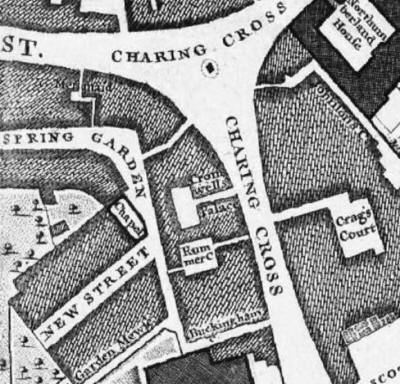

Search london history from Roman times to modern day
St Martins pub history index

Rummer court, Charing Cross in 1746 -
John Rocque map
Locket's ordinary, no present-day representative exists. When Leigh Hunt wrote "The Town" he declared that it was no longer known where it EXACTLY stood, but more recent investigators have discovered that Drummond's banking house covers its site.
ADAM LOCKET was the landlord of a famous " ordinary " tavern close to Buckingham Court, Spring Gardens, which is often mentioned in the plays of Cibber and Vanbrugh, and which catered for the Horse-guard. The site is now occupied by Drummond's bank.
It was much frequented by Sir George Etheridge until he had run up a bill that he was unable to pay, when he began to absent himself.
Mrs. Locket thereupon sent a man to dun him, and threaten him with a prosecution if he did not pay. Sir George, an utter pococurantly sent back word to Mrs. Locket that if she stirred a step in the matter he would kiss her. On receiving this answer, the good lady, much exasperated, called for her hood and scarf, and told her husband, who interposed, that "she would see if there was any fellow alive who would have the impudence." " Prithee ! my dear, don't be so rash," said her husband ; " there is no telling what a man may do in his passion ! " * The original Locket was dead in 1688, but an Edward Locket inhabited the same house till 1702.
In the "London Gazette" for 1693, notice is given by the latter that he had taken the Bowling Green House on Putney Heath, "where all gentlemen may be entertained." This seems to be identical with the bowling-green attached to the picturesque " Green Man " tavern on the right as one emerges from Putney on to the Heath, and which is still standing.
When Drummond's Bank, was rebuilt in 1879, on the site of Lockett's and the Bull's Head taverns, the excavations revealed fossil remains of the cave lion, the mammoth, and the Irish elk, and, in the upper deposits, the Celtic ox, the horse, and the sheep. These foundations, the excavations for which were attended by great difficulties, reached to a depth exceeding thirty feet, and it is said, of course exaggeratedly, that it cost more to draw the water off for the foundations than it did to build the bank itself. The writer has himself seen the shells of freshwater species thrown up in the "alluvial gravel" during excavations both on the site of the new Government Offices in Spring Gardens and during the deep diggings for the lavatories near the King Charles statue — the first conveniences, reputedly, of their kind in London. The purchasing from a labourer is also remembered of a fossil nautilus, which, except for the remnants of its silvery shell, was a mass of white day exuding moisture at every pore. This was discovered at a depth of about thirty or forty feet, while digging foundations in Water Lane, Blackfriars. The nautilus also came from the "alluvial gravel."
It was at the Bull's Head tavern that Pepys looked down the barrel of his " French gun," newly purchased firom Truelocke, the £unous gunsmith, with as many misgivings as some persons examine the mouth of a gift horse. " A very good piece of work," he says, " and truly wrought ; but for certain not a thing to be used much with safety ; and he " {i.e. the gunsmith) " do find that this very gun was never shot off" {Diary March 29, 1667).
Trying to avoid privacy and cookie settings overwriting content